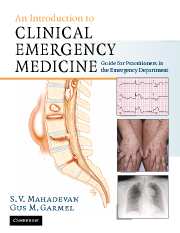Book contents
- Frontmatter
- Contents
- List of contributors
- Foreword
- Acknowledgments
- Dedication
- Section 1 Principles of Emergency Medicine
- Section 2 Primary Complaints
- Section 3 Unique Issues in Emergency Medicine
- Section 4 Appendices
- Appendix A Common emergency procedures
- Appendix B Wound preparation
- Appendix C Laceration repair
- Appendix D Procedural sedation and analgesia
- Appendix E Focused assessment with sonography in trauma
- Appendix F Interpretation of emergency laboratories
- Index
Appendix C - Laceration repair
Published online by Cambridge University Press: 27 October 2009
- Frontmatter
- Contents
- List of contributors
- Foreword
- Acknowledgments
- Dedication
- Section 1 Principles of Emergency Medicine
- Section 2 Primary Complaints
- Section 3 Unique Issues in Emergency Medicine
- Section 4 Appendices
- Appendix A Common emergency procedures
- Appendix B Wound preparation
- Appendix C Laceration repair
- Appendix D Procedural sedation and analgesia
- Appendix E Focused assessment with sonography in trauma
- Appendix F Interpretation of emergency laboratories
- Index
Summary
Scope of the problem
Emergency physicians evaluate over 12 million patients with wounds in emergency departments (EDs) each year. They provide a wide spectrum of wound care, including laceration repair. This chapter addresses wound assessment and modalities of laceration repair.
Anatomic essentials
As the body's largest and the most exposed organ, the skin is subject to a variety of external forces encountered in daily activities. The skin's anatomic structure and layers must be considered when planning a repair (Figure C.1).
Lacerations penetrating only the epidermis are minor and may not warrant major repair. The underlying dermis is one to several millimeters thick depending on its location on the body. The repair of this layer provides structural integrity for a healing wound. In some cases, especially wounds under tension, a separate deep dermal layer of closure may be required. The dermis rests on subcutaneous tissue which contains adipose and other loose connective tissue. The repair of subcutaneous tissue does not contribute to final wound strength. Re-approximation of subcutaneous tissue can eliminate potential spaces, thereby decreasing risk of infection in selected wounds.
Wound healing and the final cosmetic outcome of a laceration repair depend on many factors, including dynamic and static tension. Static tension is determined by intrinsic skin factors such as collagen concentration. Anatomic determinants such as underlying bone, tendon, muscle and location over a joint space impact the dynamic tension of the repaired laceration. Natural lines of tension exist all over the body (Figure C.2).
- Type
- Chapter
- Information
- An Introduction to Clinical Emergency MedicineGuide for Practitioners in the Emergency Department, pp. 713 - 724Publisher: Cambridge University PressPrint publication year: 2005



